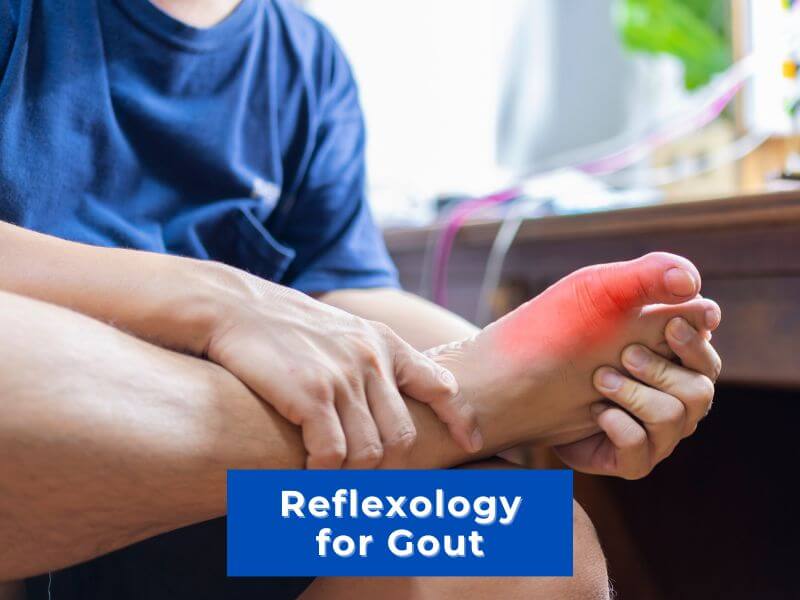If you’ve ever found yourself fidgeting in bed at night with a constant urge to move your legs, then you have probably experienced Restless Legs Syndrome (RLS). This common condition affects 1 in 10 people and can significantly disrupt your sleep and diminish your quality of life. Is there a complementary approach to ease these symptoms? Reflexology is a therapy that might hold the key to relief. In this post, we’ll delve into how reflexology for Restless Legs Syndrome could be a game-changer if you seek comfort and tranquillity from this restless ailment.
Contents
Causes and Symptoms of RLS
Irritable or Restless Leg Syndrome is a condition that affects the nervous system. Sufferers experience an uncontrollable urge to move their legs, often accompanied by unpleasant and strange sensations in the lower limbs, such as crawling, itching, or throbbing.
Symptoms of Restless Leg Syndrome are usually worse when resting, especially at night. While some people may experience the symptoms only occasionally, others may have them every day. The severity of the symptoms can also vary from mild to severe. In severe cases, the condition can be very distressing and disrupt a person’s daily activities.
The exact cause of RLS is not always clear. In many cases, it’s idiopathic, meaning it arises without a known cause and can be hereditary. However, RLS can also be secondary to other medical conditions, such as iron deficiency anaemia or kidney failure.
According to neurologists, Restless Leg Syndrome (RLS) symptoms may be connected with how the body processes dopamine. Dopamine plays a crucial role in controlling muscle movements, which is why it might be responsible for the restlessness of the legs in RLS. The symptoms of RLS are more prominent when an individual is at rest because the levels of dopamine decline during this time.
Can Reflexology Help Restless Leg Syndrome?
Some people feel reflexology is just a foot massage, but it is much more than that. The concept behind reflexology is that specific points located on the ears, hands, and feet correspond to different organs and systems of the body. By stimulating these areas, reflexologists believe they can promote health and well-being, address imbalances, and alleviate various health issues.
It’s a targeted approach where each pressure point is thought to influence the health of corresponding body parts through energy pathways.
While reflexology is not a substitute for medical treatment, it can be used as a complementary treatment for Restless Leg Syndrome. Reflexology is worth exploring if you’re looking for a natural and non-invasive way to manage the condition.
Benefits of Reflexology for Restless Legs Syndrome
Restless Leg Syndrome (RLS) can be a challenging condition to manage. However, reflexology has shown promise in alleviating symptoms associated with RLS. Here are some of the benefits of reflexology for Restless Legs:
- Enhancing Circulation: Improved blood flow can help reduce the symptoms of RLS, particularly the irritable, crawling or creeping sensations that many sufferers experience.
- Reducing Stress and Anxiety: RLS symptoms can be worsened by stress and anxiety. Reflexology may help by reducing stress and promoting relaxation.
- Promoting Balance in the Nervous System: Reflexology might help balance the autonomic nervous system, which controls involuntary actions like muscle movements, thus potentially easing RLS symptoms.
- Improved Sleep Quality: RLS often disrupts your sleep pattern. Reflexology can aid in improving sleep quality by inducing relaxation and reducing the severity of symptoms that interfere with sleep.
- Hormonal Balance: Reflexology can aid in balancing hormones in the body, which might be particularly beneficial for women experiencing RLS due to hormonal changes during pregnancy, menstruation, or menopause.
Research and Studies on Reflexology for RLS
Recent studies have begun to explore the effectiveness of reflexology in managing Restless Legs Syndrome (RLS), particularly among patients undergoing hemodialysis.
Study 1: Reflexology vs. Swedish Massage
A study compared the effects of reflexology and Swedish massage on RLS and sleep quality in hemodialysis patients. The study involved 90 patients divided into three groups: reflexology, Swedish massage, and a sham group. After four weeks, the reflexology group showed significant improvements in RLS symptoms and sleep quality immediately after the treatment, more so than the other groups.
Study 2: Reflexology vs. Stretching Exercises
A study compared reflexology with stretching exercises for RLS in hemodialysis patients. Involving 90 patients divided into three groups, the study found that both reflexology and stretching exercises significantly reduced RLS severity over four weeks compared to a control group.
These studies indicate that reflexology can be an effective complementary therapy for reducing RLS symptoms. Both reflexology and other non-medicinal methods, like stretching exercises, show promise in managing RLS. However, further research is needed to understand reflexology’s long-term benefits and mechanisms in RLS treatment.
How To Manage Irritable or Restless Legs
Managing Restless Legs Syndrome (RLS) often involves a combination of lifestyle changes and treatments. These can complement reflexology and provide a holistic approach to managing the condition.
Lifestyle Changes
- Regular Exercise: Moderate, regular exercise can help alleviate RLS symptoms. However, intense exercise or working out late might make symptoms worse.
- Sleep Habits: Establishing a regular sleep routine and creating a comfortable environment can reduce RLS symptoms.
- Dietary Adjustments: Reducing caffeine, alcohol, and tobacco intake can help. Some individuals may benefit from taking nutritional supplements of iron or magnesium.
- Stretching and Massage: Regular stretching and massage can complement reflexology in reducing muscle tension and improving circulation.
- Heat and Cold Therapy: Applying heat or cold packs to the legs can temporarily relieve RLS discomfort.
Finding a Qualified Reflexologist
Tips for Finding a Reflexologist
- Certifications and Training: Look for a reflexologist with certifications from reputable organisations. Search our holistic therapy directory for a trained reflexologist.
- Experience: Seek a reflexologist with expertise in treating clients with RLS.
- Referrals and Reviews: Ask for referrals from healthcare providers or check online reviews.
Conclusion
Individuals suffering from Restless Legs Syndrome can find potential benefits in reflexology. It can play a crucial role in a holistic RLS management plan by improving symptoms such as discomfort and sleep disturbances.
Do you often find yourself tossing and turning in bed due to Restless Leg Syndrome? If so, here’s a solution that’s both relaxing and enjoyable! Give this therapy a try and say goodbye to those sleepless nights.




